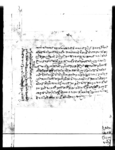A copy of a loan agreement entered into by four brothers from Navalapura for borrowing 42 mohararupaiyās from a creditor in Patan (VS 1959)
ID: K_0210_0066
Edited and
translated by Manik Bajracharya
in collaboration with
Raju Rimal
Created: 2018-08-09;
Last modified: 2020-06-25
For the metadata of the document, click here
The accompanying edition, translation/synopsis and/or commentary are available under the terms of the Creative Commons Attribution-ShareAlike 4.0 International License
Abstract
This is a copy of a bond entered into by a debtor, Kṛṣṇa Vīra Rānā of Navalapura, for borrowing 42 mohararupaiyās from a creditor named Annapūrṇā Brāhmaṇī of Patan. The debtor makes a commitment that he or one of his three brothers will serve the creditor until the debt is repaid.Diplomatic edition
[1r]
श्री\1साछी2पाटंझतापोलवस्न्यावंसीलाल्जोसी¯¯¯¯¯¯¯¯¯¯१
3पाटंकाअम्वलमध्येषल्वीटारवस्न्याकासीनाथलामीछाने१
4लेषकभादगाउदूनाचोटोलवस्नेहर्ककुमारकायेस्थ१1स्वस्तिश्रीसम्वत१९५९साल्मीतिवैसाषवदी३रोज६मातद्दीनेली
2षीतमधनीकनामसहरपाटंकाअम्वलमध्येवैलाछेतोलवस्न्याअंन्नपु
3र्णाव्राह्मणीधनवेहोरीणीकनामनवलपुरकाअम्वलमध्येवीमी
4रेगाउवस्न्याश्रीभैरवनाथपल्टं८प•सी•कृस्नवीररानागतलीह
5लचादीकासीका•मोहरूपैञा४२अछेरेपीवयालीसरूपैञाक
6र्जालीयासोरूपैञांलीयाकोव़ावतमेरामाहीलाभाइकोवीहा
7गर्नाकेलीयाकोहोसोरूपैञामध्येहामी४भाइमा१भाइहामीरूजु
8रहीकामदीउलासाहुलेरूपैञाकोव्याजनषोजनु•असामीलेइमान
9षोजनु•सोरूपैञानतिरुंज्याल्•साहुकोकाम४भाइमा१भाइमा
10१भाइलेकामदींउलाभनिहाम्रामनोमान⟪राजि⟫षुसीलेसाहुलाइ
11त्मसुकलेषीदीञ्यूंयेसवातकासाछीवसीस्हीछापगर्न्याफट्
12केपट्टीलेषीयाकाछंमीतिसदरशुभ्म्¯¯¯¯¯ ¯¯¯¯¯¯¯
Translation
[1r]
Śrī
Witnesses:
Vaṃsīlāl Josī, resident of
Jhatāpola in Patan - 1
Kāsīnātha Lāmichāne, resident of
Khalvīṭāra1 in the district (ambala) of Patan -
1
Scribe Harka Kumāra Kāyestha, resident of
Dūnāco Ṭola in Bhaktapur - 1
Hail! Likhitama: Friday, the 3rd of the dark fortnight of Vaiśākha in the [Vikrama] era year 1959 (1902 CE). On this day, [I] the debtor named Kṛṣṇa Vīra Rānā, a soldier (sipāhī)2 in the 8th squad (paṭṭī)3 of the Bhairavanātha Palṭana, and a resident of Vīmīre Gāu within [the confines of] the district of Navalapura, have taken a loan of 42 mohararupaiyās, in words forty-two, of current legal currency (gatalīhala) [from] the creditor named Annapurṇā Brāhmaṇī, a resident of Vailāche Ṭola within [the confines of] the district of Patan. I have taken this loan for [covering the cost of] my second brother's marriage. For this money, 1 [or the other] of us 4 brothers will remain present and work [for you]. The creditor shall not ask for interest on the [principal] sum. The debtor shall not ask back the value of daily work (nimeka). We have willingly drawn up this loan agreement (tamasuka), declaring that 1 [or the other] of us 4 brothers will work for the creditor until the [principal] amount is repaid. [The names of] the people who have signed standing witness to this deed are written in the margin. The date is valid. Auspiciousness.
Commentary
This document is a loan agreement between the debtor Kṛṣṇa Vīra Rānā and the creditor Annapurṇā Brāhmaṇī. The debtor is a resident of Bimire which currently lies in Nawalpur municipality of Sindhupalchok district. The creditor, as the name suggests, is a Brahmin woman. Her place of residence, spelled Vailāche Ṭola, is probably Bhelāchẽ, a locality to the north-east of Patan Darbar Square. Kṛṣṇa Vīra, who apparently was the eldest of four brothers, borrowed 42 mohararupaiyās in order to cover the cost of his second brother's marriage. To repay the loan, he agrees that one or the other of the brothers will serve the creditor. The deed thus clearly contain a usufructuary pledge of bonded servitude, even if no word such as dhito, bādhā or bandhaka that denotes a pledge or a bondservant is found in it. Nor does it mention the names of the debtor's other brothers. The Mulukī Ain of 1854 (Ain-54 § 82.10) has a rule regarding working for a creditor by rotation: that only a designated bond servant can be compelled to work, but if that person dies, the creditor cannot force subsitutes to work for him.

